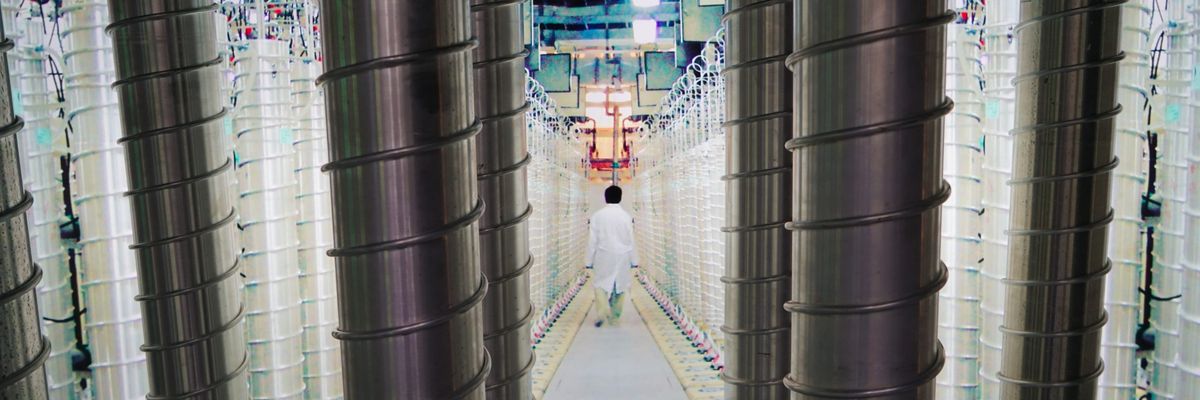The International Atomic Energy Agency (IAEA) is reportedly planning to rebuke Iran for its lack of cooperation with the Agency and for refusing to provide access to sites related to its nuclear program.
Israeli Prime Minister Benjamin Netanyahu referred to the sites in question in his speech to the United Nations General Assembly in 2018, calling them “Iran’s Secret Atomic Warehouse.” Netanyahu claimed that Israel had obtained information about these sites — including a trove of documents that purportedly contain information on nuclear weapons design — through secret operations.
At the time, then-IAEA Director General Yukiya Amano resisted pressures to insist that Iran allow visits to these sites, partly because the Joint Comprehensive Plan of Action (JCPOA) — the 2015 nuclear agreement — had closed the chapter on the so-called Possible Military Dimensions (PDM) of Iran’s nuclear program after the IAEA had satisfied itself that, at least since 2003, Iran had not pursued nuclear weaponization. The IAEA is now effectively reopening the PMD dossier.
Considering that the IAEA’s inspections of Iran’s declared nuclear sites, since the JCPOA’s implementation, have so far not shown any diversion of nuclear material to weaponization, the question arises as to why the IAEA is hardening its position now.
The most simple answer is that the agency is pressuring Iran for abandoning some of its JCPOA commitments after Trump unilaterally reimposed sanctions, namely by increasing the rate of its uranium enrichment and its reserves of enriched uranium. The agency could also be using the charge of non-cooperation to force Iran’s hand on other issues. Another possible explanation is that the new Director General, Rafael Grossi, an Argentine diplomat, is more distrustful of Iran than was his predecessor, although Amano could hardly have been considered as naïve when it came to Iran’s nuclear program.
A more sinister interpretation is that the agency is taking this new tack on the instructions of its new director, who, in turn, might be operating under pressure from the United States and possibly the Europeans to tighten the screws on Tehran.
With Grossi in charge there was bound to be a change in the agency’s approach and many expected him to be tough on Iran. Grossi was also the United States’ preferred candidate for the IAEA’s directorship. The way various appointments in international organizations are done, the United States would not have favored Grossi if it was not confident that he would adjust the agency’s approach to Iran in accordance with Washington’s preferences.
Meanwhile, the U.S. maximum pressure strategy has not yielded the result that Washington had hoped. It has not yet brought Iran to the negotiating table, nor has it caused the unravelling of the Islamic Republic. This situation has led Iran hawks in the U.S. to renew their call for additional sanctions and more pressure on Iran. To do so, they believe that the United States should try to have Iran’s nuclear dossier once more sent to the United Nations’ Security Council to convince its members to reimpose U.N.-mandated sanctions on Iran. Sen. Tom Cotton is one of the Iran hawks who favors this strategy. A report by the IAEA claiming that Iran is not fully cooperating with the agency might just do the trick and get Iran’s dossier sent to the UNSC.
In addition to the forthcoming IAEA report chastising Iran, there have been reports of Iran’s increased reserves of uranium, suggesting that Iran now has enough fuel to make a nuclear device in a relatively short time should it choose to do so. In short, we are once again back where we were before the signing of the JCPOA five years ago: some guardrails are off Iran’s nuclear program with those pushing for war or regime change hyping the threat.
The way forward
Clearly, some of Iran’s steps in walking back some if its JCPOA commitments, although still within its parameters, are cause for concern. There is also the fear that Iran, feeling isolated and literary starved by sanctions, might see its only salvation in making a primitive nuclear device, although there is no viable indication that it has the technology required to do so. The reasonable way to deal with these risks is to go back to the JCPOA and then talk about more safeguards and demands for visits to areas of special concern. At the very least, there could be some sanction relief in exchange for Iran agreeing to allow IAEA inspectors to visit the suspected locales.
However, it is certain that the U.S. administration will not follow this approach. This is evidenced by suggestions that in any prospective new talks between the U.S. and Iran, regional states such as Saudi Arabia and the UAE, among others, should also take part. Moreover, other issues such as Iran’s missile program and regional policies should be included in talks. What’s more problematic is the fact that if Iran’s Arab neighbors are included in any future talks, they would certainly raise other bilateral issues beyond the nuclear dossier. But there is no way that Iran could agree to such humiliating conditions.
Under such conditions, most probably, the issue of military strike will once again be brought to the table, especially since many hawks in the U.S. and certainly in Iran’s Arab neighbors, despite their fears of the risks of a U.S.-Iran war, have not been happy that Iran thus far has escaped the devastating impact of a potential U.S. military attack. These heightened risks of conflict demand that those in the United States and Europe who do not want another devastating regional war on top of the coronavirus pandemic should not remain complacent. They should not allow new economic and political pressures on Iran, including those of the IAEA, to eliminate any chance of compromise and leave only military conflict as the remaining option.















